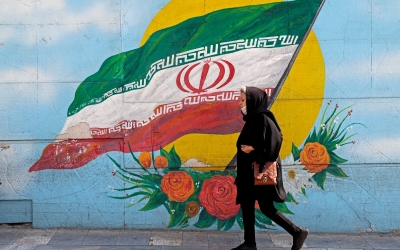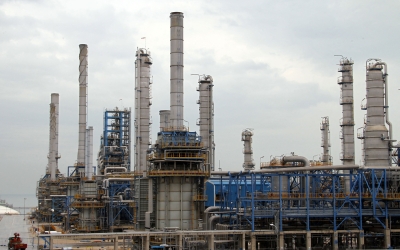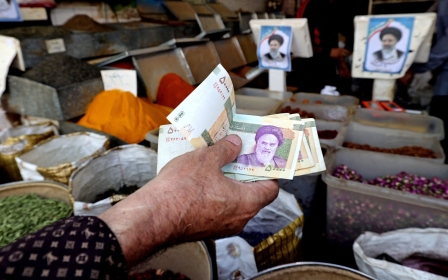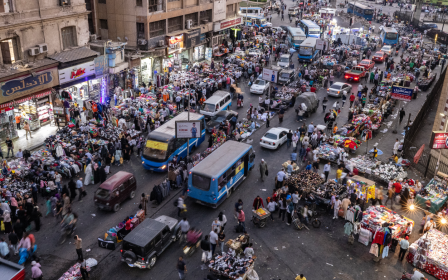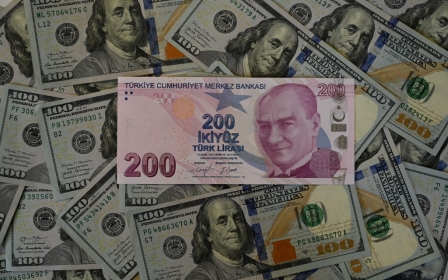Iran's currency nosedives as government grapples with protest movement

Iran's currency has weakened to record lows against the US dollar, as general strikes and popular protests triggered by the death of 22-year-old Mahsa Amini in police custody continue to paralyse the country.
The rial dropped to 384,000 against the US dollar earlier this week, an almost 50-percent decline in 15 months. It was trading at 280,000 in August 2021, when hardline President Ebrahim Raisi was elected.
Businesspeople, students and holidaymakers have been the hardest hit, with government efforts to control currency markets backfiring.
'Many businesses do not know what the next week will look like'
- Ali Dadpay, University of Dallas
High inflation has significantly eroded ordinary Iranian's disposable income, with outbound travel another fallout from the economic crisis.
In October, the head of the Association of Air Transport and tourist agencies of Iran, Hormatollah Rafie, revealed that trips overseas had fallen by 50-60 percent, which he primarily ascribed to the economic and social aftershocks of the protests.
New MEE newsletter: Jerusalem Dispatch
Sign up to get the latest insights and analysis on Israel-Palestine, alongside Turkey Unpacked and other MEE newsletters
In November, the three Iranian cities of Isfahan, Kish and Mashhad that were slated to operate exclusive flights to Doha for the Qatar World Cup had to cancel them due to a lack of demand.
The Islamic Republic has been gripped by one of the largest and longest-lasting demonstrations in its history, following the death of Mahsa Amini, a young Kurdish woman, in police custody.
More than 480 people, including 68 children, have been killed in government crackdowns, according to Amnesty International.
A bad situation has been made worse by the government instituting a crippling internet shutdown that has already knocked out the last two social media platforms that were officially accessible, namely Instagram and WhatsApp.
The restrictions were initially rolled out to contain the protests, but the authorities plan to make them permanent. Access hiccups continue to be in place, and thousands of websites remain unavailable without virtual private networks (VPNs).
"Many businesses do not know what the next week will look like, and they cannot plan for any timeline either short or long," said Ali Dadpay, an associate professor of finance at the University of Dallas.
"Definitely, there are businesses that have closed and halted their activities to show solidarity, particularly small and medium-sized enterprises. However, I must add that the government attack on worldwide internet and extreme blackouts have pushed many online businesses to shut down as well," he told Middle East Eye.
"As the risk and uncertainty increase, many Iranians will seek other means of storing value and saving to face the days and weeks ahead. A sudden increase in demand for foreign hard currency is likely, and the government does not have resources to quell it."
Tehran’s chamber of commerce has estimated that the damages incurred due to connectivity outages amount to 800 trillion rials ($2.28bn) and that up to 700,000 online stores working through Instagram have been shut down.
"Clearly, the protests and the crackdown have further weakened Iran’s economic performance. The biggest factor has been the throttling of the internet, which has adversely affected businesses that during the Covid period became even more dependent on social media apps," said Barbara Slavin, the director of the Future of Iran Initiative at the Atlantic Council.
"Indeed, Raisi, who promised economic improvements when he was inaugurated, has been a failure on all fronts. To have reactivated the so-called morality police on top of all these failures just underlines his lack of judgement and expertise," Slavin said. “He makes [former president Mahmoud] Ahmadinejad look competent in comparison."
'Outside pressure mounting'
The likelihood of a downward economic spiral, exacerbated by the strikes and an emerging alliance to isolate the Islamic Republic, is significant.
Iran's overseas agenda is also unhelpful to the status quo, meaning that it has notably limited its choice of partners worldwide, especially since taking sides in the Russian invasion of Ukraine.
"The economic future does not look rosy as outside pressure on Iran, from Persian Gulf Arabs, Israel, EU and the US is also mounting, and Iran’s choice of allies, Russia and Belarus, will also present future problems," said Hossein Askari, an economist and professor emeritus of international business at George Washington University.
'Clearly, the protests and the crackdown have further weakened Iran’s economic performance'
- Barbara Slavin, Atlantic Council
"I have also felt that the outlook for oil prices is not as rosy as others have thought. When oil was at about $90 about a month ago and others felt it would go much higher, I predicted a $70-80 range because of the impending global economic downturn," he told MEE.
The Statistical Center of Iran reported that annual inflation soared to 44 percent in November, and with new bundles of sanctions being introduced by the United States, European Union and Canada, the situation could worsen.
Experts say that friction in the government's economic team suggests there is no roadmap to deal with a blend of problems including turbulence besetting the forex market, unemployment and a menacing housing crisis.
When labour minister Hojjat Abdolmaleki resigned in June for unannounced reasons, President Raisi nominated Mohammad Hadi Zahedivafa, an ultra-conservative ally, to fill the vacancy.
But following weeks of handwringing, Zahedivafa failed to secure a vote of confidence, and another Raisi loyalist, Sowlat Mortazavi, was eventually appointed as the minister.
Another mishap for the administration had been the resignation of Rostam Ghasemi, the minister of roads and urban development, who passed away on 8 December.
The retired Islamic Revolutionary Guard Corps commander had cited health issues for stepping down. His critics had pointed at his failure to at least partially fulfil his promise of constructing four million affordable housing units.
In an announcement that didn’t receive much media publicity, the head of the Plan and Budget Organisation, Masoud Mir-Kazemi, said earlier in November that Raisi has asked for permission from the Supreme Leader to withdraw 20 percent of this year's oil revenues from the National Development Fund of Iran to be used for "employment and proprietorship" purposes.
Ayatollah Khamenei has allowed the administration to use 10 percent of the earnings. The depository is a sovereign wealth fund that stores Iran’s oil revenues, and its only treasurer is the ayatollah, who should give the nod to any president to extract money from it.
The rare permission granted can be a hint that the government is facing an imminent fiscal calamity that is not widely acknowledged because the protests are absorbing public attention.
"Government will certainly have more serious challenges in financing its own budget in the next phases of the revolution after strikes expand through private and also public sectors," said Mahdi Ghodsi, an economist at the Vienna Institute for International Economic Studies.
"The US administration has also tightened its sanction regime against the Islamic Republic, and I assume that the sale of oil to China and India is already facing a new blockage. The US Treasury will push these countries even further to stop the purchase of oil.
"Then, Raisi should either print more money or use the available fund from the National Development Fund."
Middle East Eye delivers independent and unrivalled coverage and analysis of the Middle East, North Africa and beyond. To learn more about republishing this content and the associated fees, please fill out this form. More about MEE can be found here.


